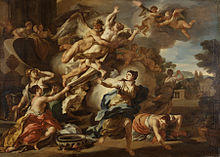Francesco Solimena | |
|---|---|
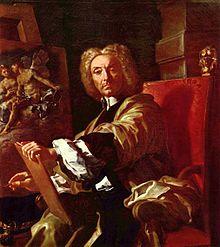 Self-portrait, 1730 | |
| Born | 4 October 1657 |
| Died | 3 April 1747 (aged 89) |
| Nationality | Italian |
| Education | Francesco di Maria |
| Known for | Painting |
| Movement | Baroque |
| Patron(s) | Pope Benedict XIII |
Francesco Solimena (4 October 1657 – 3 April 1747) was a prolific Italian painter of the Baroque era, one of an established family of painters and draughtsmen.
Biography
Francesco Solimena was born in Canale di Serino, province Avellino.
He received early training from his father, Angelo Solimena, with whom he executed a Paradise for the cathedral of Nocera (a place where he spent a big part of his life) and a Vision of St. Cyril of Alexandria for the church of San Domenico at Solofra.[1]
He settled in Naples in 1674, there he worked in the studio of Francesco di Maria.[1] He was patronized early on, and encouraged to become an artist by Cardinal Vincenzo Orsini (later Pope Benedict XIII).[1] By the 1680s, he had independent fresco commissions, and his active studio came to dominate Neapolitan painting from the 1690s through the first four decades of the 18th century. He modeled his art—for he was a highly conventional painter—after the Roman Baroque masters, Luca Giordano and Giovanni Lanfranco, and Mattia Preti, whose technique of warm brownish shadowing Solimena emulated. Solimena painted many frescoes in Naples, altarpieces, celebrations of weddings and courtly occasions, mythological subjects, characteristically chosen for their theatrical drama, and portraits. His settings are suggested with a few details—steps, archways, balustrades, columns—concentrating attention on figures and their draperies, caught in pools and shafts of light. Art historians take pleasure in identifying the models he imitated or adapted in his compositions. His numerous preparatory drawings often mix media, combining pen-and-ink, chalk and watercolor washes.
A typical example of the elaborately constructed allegorical "machines" of his early mature style, fully employing his mastery of chiaroscuro, is the Allegory of Rule (1690) from the Stroganoff collection, which has come to the State Hermitage Museum, St Petersburg.
Francesco Solimena amassed a fortune and lived in sumptuous style founded on his success. He died at Barra, near Naples, in 1747.
As Solimena had intended it, his nephew Orazio became his pupil and successor as a painter.[2]
Career
His large, efficiently structured atelier became a virtual academy, at the heart of cultural life in Naples. Among his many pupils were Francesco de Mura (1696–1784), Giuseppe Bonito (1707–89), Pietro Capelli, Domenico Mondo, Onofrio Avellino, Scipione Cappella, Giovanni della Camera,[3] Francesco Campora,[4] Alessandro Guglielmi,[5] Leonardo Oliviero,[6] Salvatore Olivieri,[7] Salvatore Pace,[8] Romualdo Polverino,[9] Paolo Gamba, Evangelista Schiano, Gaspare Traversi, Eugenio Vegliante, and most notably Corrado Giaquinto and Sebastiano Conca. The Scottish portraitist Allan Ramsay spent three years in Solimena's studio.[10]
- Francesco Solimena
Study for the fresco cycle of the Sacristy of a church[11]
References
- ^ a b c Pavone, Mario Alberto (2003, January 1). "Solimena family". Grove Art Online.
- ^ Pavone, Mario Alberto, Precisazioni su Orazio Solimena, in: Prospettiva, 20 (1980), pp. 80–87.
- ^ Boni, Filippo de' (1852). Biografia degli artisti ovvero dizionario della vita e delle opere dei pittori, degli scultori, degli intagliatori, dei tipografi e dei musici di ogni nazione che fiorirono da'tempi più remoti sino á nostri giorni. Seconda Edizione.. Venice; Googlebooks: Presso Andrea Santini e Figlio. p. 171.
- ^ Boni, page 177
- ^ Le belle arti, Volumes 1-2, By Giovanni Battista Gennaro Grossi, Tipografia del Giornale Enciclopedico, Strada del Salvadore a Sant'Angelo a Nilo #48, Naples (1820); page 194.
- ^ Camillo Minieri-Riccio, Memorie storiche degli scrittori nati nel regno di Napoli, L'Aquila 1844, page 243.
- ^ Minieri-Riccio, page 243.
- ^ Minieri-Riccio, page 248.
- ^ Minieri-Riccio, page 279.
- ^ "Francesco Solimena, Charles Beddington Ltd". Archived from the original on 8 January 2014.
- ^ For sacristy of San Paolo Maggiore in Naples', Whitfield Fine Art
External links
- 35 paintings by or after Francesco Solimena at the Art UK site
- Francesco Solimena on-line
- J. Paul Getty Museum: Francesco Solimena
- Scuola Media F. Solimena, Canale di Serino.
- Farquhar, Maria (1855). Ralph Nicholson Wornum (ed.). Biographical catalogue of the principal Italian painters, by a lady. Woodfall & Kinder, Angel Court, Skinner Street, London.
- Wittkower, Rudolf (1980). Art and Architecture in Italy, 1600-1750. Pelican History of Art (Penguin Books Ltd). pp. 462–465.
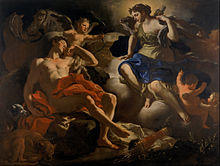
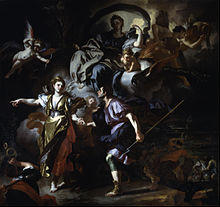
.jpg)
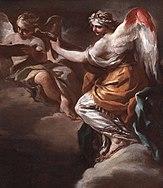
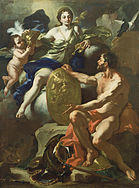
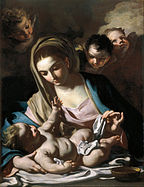
_-_Noli_me_tangere.jpg)
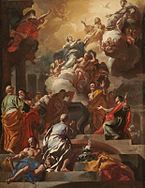
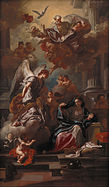
.jpg)
